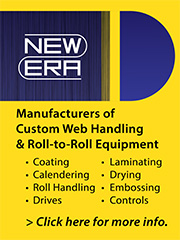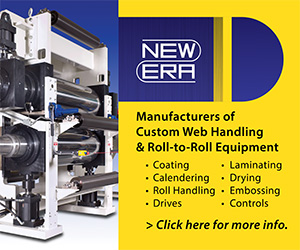-
Published: December 12, 2018
Submitted by Tom Kerchiss, RK Print Coat Instruments Ltd
Thin flexible substrates are sometimes modified and combined to produce substrates with enhanced layer properties not normally obtainable from any single source material. The benefits associated with modified substrates vary but can include improved physical strength, thermal stability, permeability as well as optical strength. The base material, method of manufacture and additional surface modifications, often made at time of production may make the choice of one substrate over another easier to decide upon. Substrates may be valued either for the inherent surface qualities, gloss, etc., or for the degree of functionality that they offer, for instance, sealability, barrier resistance, etc.
Film manufacturers and formulators produce modified structures from polymers such as polyethylene, polyester and polypropylene. It is the method of manufacture or conversion of these polymers that enables a substrate to meet many aesthetic or functional requirements. Polyethylene for example: when modified and in the form of Polyethylene Terephthalate (PET) provides good gas/aroma and moisture resistance making it suitable for applications such as carbonated soft drink bottles, snack food wrappers and boil in the bag. Additional properties associated with PET include heat resistance and good mechanical strength.
Cellulose is a good example of how a material can be manipulated in practice to meet specific requirements. Cellulose may be engineered so that it is opaque and permeable. This is achieved through matting fibres together in the same manner as paper. Alternatively, cellulose can be made semi-permeable and clear by dissolving and precipitating the polymer, a process known as ‘solution casting.’ Regardless of the technique, the polymer retains high thermal stability but the differing manipulative techniques extend application possibilities. And this is the case with many of the substrates and indeed the ink and coating consumables.
Manufacturing methods typically used for polymer films are melt blown, melt casting and uni-axially or bi-axially orientating the polymers. Blown and cast films have low levels of molecular orientation and are for the most part highly extensible, offering good tear and impact resistance. When films are produced with the molecular orientation increased, physical properties such as tensile strength and stiffness increase but elongation is reduced.
The physical, thermal and substrate properties determine to a large extent the suitability of a film for a process. However, perhaps the key question that is at the back of every converters mind is what will happen when we come to run it on and through the processing machine?
The film must be strong enough and stiff enough to be transported through the process without permanently stretching or breaking at equable temperature levels and at the required level of tension.
Difficulties in processing come from a variety of sources, one of which can apply to composite or laminates as well as filmic multi-layered structures and that is gauge band variation. Substrate inconsistency can mean that no two rolls are exactly the same; one roll could be thinner in one spot than another. When placed in a manufacturing setting an issue such as variation in gauge may impact on quality on line speed and can affect the appearance and functionality of the roll at wind up. There is evidence to suggest that high and low spots in the substrate increases the risk of web breaks.
A variation in the thickness or non-uniformity in the transverse directional profile can affect various converting processes. In coating for instance, particularly when knife coating has been selected the uniformity of the coating is undermined. In knife coating the height of the blade is determined and fixed at the beginning of the run so that substrate and coat interface is critical.
The way in which an air knife coating is applied can induce an anomaly. When the coating is applied at high speed and onto a moving web the flow is subjected to an alternating flow regime. Laminar flows on a moving web have a parabolic velocity profile with the fluid at on the surface keeping pace with the moving web. Above the web and at the air interface the coating fluid behaves differently in that it is just that little bit slower. We could summarise this by saying that the volume flow up exceeds volume flow down.
With air knife coating the thicker flow forms just below the air impingement zone or meniscus. Eventually the air knife allows the thinner coating flow to pass, excess coating liquid is then collected below the meniscus and will not flow until the lower layer grows thick enough to balance the upward shear force from the web. Ebbing and flowing disturbances may not always result in a disaster. The coating fluid may smooth well and the finish may have a varnish or enamel look. On the other hand the coating may exhibit streaking or chatter and the only course of action is to experiment and find a surfactant that can provide a post coating smoothing finish. If this course of action is followed the surfactant must be one that does not compromise wetting and adhesion properties.
Multi-layered films as already mentioned are produced by co-extrusion, blown film or cast extrusion with each layer or melt bought together to form a single unified product. Of course there are other ways of combining structures together such as extrusion coating and film lamination, etc. Lamination allows for a wider range of products to be developed to meet the increasingly complex needs of sectors such as flexible packaging. In essence two or more plastic film or non-filmic materials such as aluminium foil, papers, etc., are combined or married together. A variety of options exist including extrusion laminating; adhesive laminating and wax/hot melt lamination.
Deciding whether to extrusion coat, extrusion laminate or film laminate depends on the length of the run being undertaken and most importantly on what is required from the finished product.
Extruded operations are not always commercially viable for short runs. If the quantity of material to be used in limited and the process meets the dictates of the application then adhesive laminating is an option. The permutations available include but are not limited too: solvent based adhesives for dry bond adhesive laminating; single or multi component water based adhesive for wet bond; two component solvent-less adhesives and UV or EB curable adhesives.
Wax/hot melt lamination whereby a layer of wax or hot melt is sandwiched between plies is another option. With this method it is necessary to bear in mind that this method is not suitable for packaging that is going to be heat-sealed or for a packaging product that is going to be filled with a hot solid or liquid.
Good housekeeping, that is cleaning cylinders and laminator after each run and routinely evaluating coating weights should be done as a matter of course. Coating weight accuracy is a key operating parameter. If out of spec, bonding can be affected resulting in bubbling, blister or even de-lamination. When tension is too high even a forgiving material such as PET can stretch. Travelling through the nip a film will naturally relax and contract. Most adhesives also tend to shrink as they cure. The risk is that both the substrate and the adhesive shrink and sheets will curl.
Adding coating or lacquers provides additional methods whereby substrates can be modified, manipulated or value added. Heat seal coatings, primers, protective coatings and release lacquers, etc., are all up for consideration.
Quality control, test and product development devices have much to offer, reducing waste, speeding throughput and R & D. A benefit of systems such as the Rotary Koater designed and developed by RK Print Coat Instruments are that they allow for experimentation, providing the means whereby the users can select from a wide range of coating/print head and lamination technologies so that the most suitable applicator for the application is chosen
Moreover with systems such as the Rotary Koater or customer bespoke VCM a choice of web path and drying technologies are available. For instance web path possibilities for laminating with the Rotary Koater could be: gravure/hot air drying/lamination; corona treat/direct gravure coating/hot air drying/lamination/cooling or knife over roll coating/hot air drying/lamination, etc.
Systems can be configured for clean room conditions; hot air, infrared and UV curing can be selected and corona, flame treatment technologies can be supplied. Pilot coating/print and laminating systems, the Rotary Koater and VCM are also able to undertake small-scale production so that issues that could become apparent when a job is mounted on a full-scale production machine are highlighted and can be resolved.
CONTACT COMPANY







